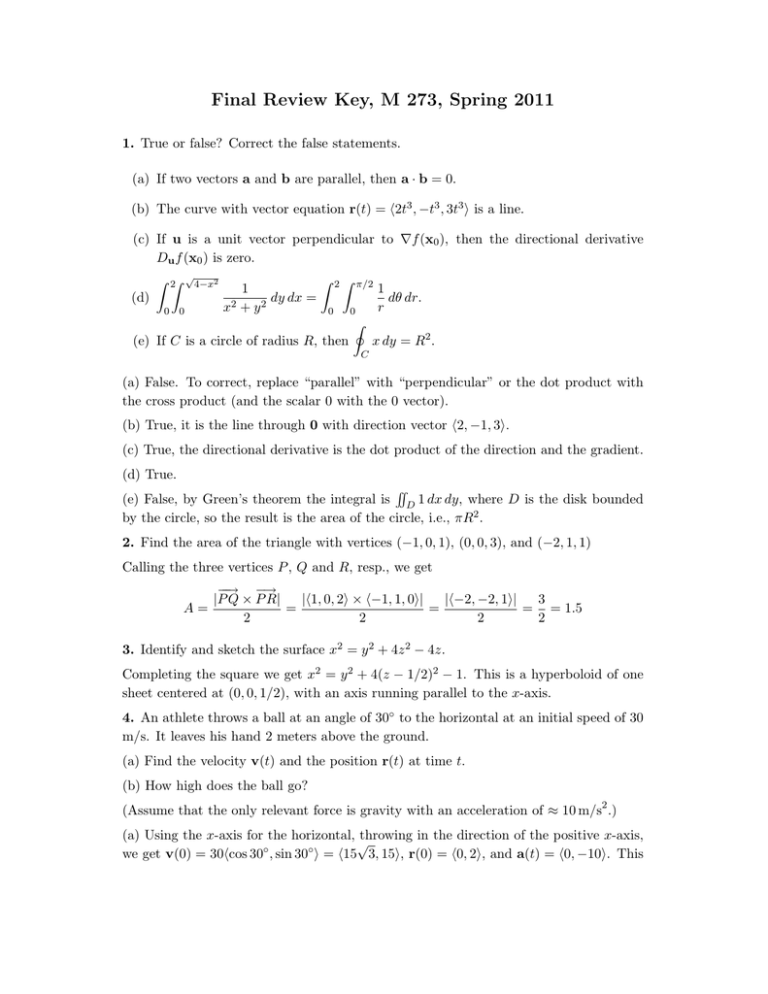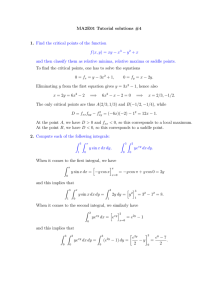Final Review Key, M 273, Spring 2011
advertisement

Final Review Key, M 273, Spring 2011 1. True or false? Correct the false statements. (a) If two vectors a and b are parallel, then a · b = 0. (b) The curve with vector equation r(t) = h2t3 , −t3 , 3t3 i is a line. (c) If u is a unit vector perpendicular to ∇f (x0 ), then the directional derivative Du f (x0 ) is zero. √ Z 2Z (d) 0 0 4−x2 1 dy dx = 2 x + y2 Z 2 Z π/2 0 0 I (e) If C is a circle of radius R, then 1 dθ dr. r x dy = R2 . C (a) False. To correct, replace “parallel” with “perpendicular” or the dot product with the cross product (and the scalar 0 with the 0 vector). (b) True, it is the line through 0 with direction vector h2, −1, 3i. (c) True, the directional derivative is the dot product of the direction and the gradient. (d) True. RR (e) False, by Green’s theorem the integral is D 1 dx dy, where D is the disk bounded by the circle, so the result is the area of the circle, i.e., πR2 . 2. Find the area of the triangle with vertices (−1, 0, 1), (0, 0, 3), and (−2, 1, 1) Calling the three vertices P , Q and R, resp., we get −−→ −→ |P Q × P R| |h1, 0, 2i × h−1, 1, 0i| |h−2, −2, 1i| 3 A= = = = = 1.5 2 2 2 2 3. Identify and sketch the surface x2 = y 2 + 4z 2 − 4z. Completing the square we get x2 = y 2 + 4(z − 1/2)2 − 1. This is a hyperboloid of one sheet centered at (0, 0, 1/2), with an axis running parallel to the x-axis. 4. An athlete throws a ball at an angle of 30◦ to the horizontal at an initial speed of 30 m/s. It leaves his hand 2 meters above the ground. (a) Find the velocity v(t) and the position r(t) at time t. (b) How high does the ball go? (Assume that the only relevant force is gravity with an acceleration of ≈ 10 m/s2 .) (a) Using the x-axis for the horizontal, throwing in the direction of the positive x-axis, √ we get v(0) = 30hcos 30◦ , sin 30◦ i = h15 3, 15i, r(0) = h0, 2i, and a(t) = h0, −10i. This implies Z v(t) = v(0) + t √ √ a(s) ds = h15 3, 15i + h0, −10ti = h15 3, 15 − 10ti 0 and Z r(t) = r(0) + t √ √ v(s) ds = h0, 2i + h15 3t, 15t − 5t2 i = h15 3t, 2 + 15t − 5t2 i 0 (b) At the highest point the vertical component of the velocity is 0, so it occurs when 15 − 10th = 0, i.e., at th = 15/10 = 3/2. The vertical component of the position at this = 53 time is 2 + 15th − 5t2h = 2 + 45/2 − 45/4 = 8+90−45 4 4 = 13.25. So the highest point is 13.25 meters above the ground, occurring 1.5 seconds after the throw. 6 at the point (1, 2, 1). 5. Find the tangent plane to the surface z = 1 + x2 + y 2 The surface is the level surface F (x, y, z) = (1 + x2 + y 2 )z = 6. We know that gradients are perpendicular to level surfaces. Then ∇F (x, y, z) = h2xz, 2yz, 1 + x2 + y 2 i, and ∇F (1, 2, 1) = h2, 4, 6i is a normal vector to the tangent plane, giving the equivalent equations (one of these is good enough) hx − 1, y − 2, z − 3i · h2, 4, 6i = 0, hx, y, zi · h2, 4, 6i = h1, 2, 1i · h2, 4, 6i = 16, 2x + 4y + 6z = 16. 6. Find and classify the critical points of f (x, y) = x3 − y 3 + 3xy. First and second derivatives are fx (x, y) = 3x2 + 3y fy (x, y) = −3y 2 + 3x fxx (x, y) = 6x fyy (x, y) = −6y fxy (x, y) = 3 The critical points are solutions of 3x2 + 3y = 0 and −3y 2 + 3x = 0. From the second equation x = y 2 , plugging into the first equation and dividing by 3 gives 3y 4 + 3y = 0. This equation has two solutions, y = 0 and y = −1. From x = y 2 we get the two critical points (0, 0) and (1, −1). For the second derivative test, D = fxx (x, y)fyy (x, y) − (fxy (x, y))2 = −36xy − 9. At (0, 0) we get D = −9 < 0, so there is a saddle at (0, 0). At (1, −1) we get D = 36 − 9 > 0 and fxx (1, −1) = 6 > 0, so there is a local minimum at (1, −1). 7. Find the maximum and minimum values of f (x, y, z) = 8x − 4z on the ellipsoid x2 + 10y 2 + z 2 = 5. Lagrange multipliers with g(x, y, z) = x2 + 10y 2 + z 2 gives 8 = 2λx 0 = 20λy −4 = 2λz From the first and/or third equation we see that λ 6= 0, so from the second equation we get y = 0. Multiplying the third equation by 2 and adding it to the first equation gives 0 = 2λx + 4λz = 2λ(x + 2z). Again, since λ 6= 0 we get x + 2z = 0, so x = −2z. Plugging everything into x2 + 10y 2 + z 2 = 5 gives 5 = (−2z)2 + 02 + z 2 = 5z 2 . This has two solutions, z = ±1, so the whole system has the two solutions (−2, 0, 1) and (2, 0, 1) for (x, y, z). (We do not really care what λ is.) Plugging both into f we get f (−2, 0, 1) = 8 · (−2) − 4 · 1 = −20 and f (2, 0, −1) = 8 · 2 − 4 · (−1) = 20, so the maximum is 20 and the minimum is −20. 8. Consider a triangular lamina D with vertices (0, 0), (1, 0), and (0, 1), with mass density ρ(x, y) = 1 + x + y. Find its total mass. y=1−x y2 m= ρ(x, y) dA = (1 + x + y) dy dx = y + xy + dx 2 y=0 D 0 0 0 1 Z 1 Z 1 (1 − x)2 3x − x2 − x3 /3 3 − 2x − x2 dy = dx = = (1 − x) + x(1 − x) + 2 2 2 0 0 0 3 − 1 − 1/3 5 = = . 2 6 Z 1Z ZZ √ Z 2Z 4−z 2Z √ Z 1 4−z 2 −y 2 9. Evaluate z dx dy dz by changing to spherical coordinates. 0 0 √ Z 2Z 1−x 0 4−z 2Z √ 4−z 2 −y 2 Z 2Z π/2Z π/2 z dx dy dz = 0 0 Z 0 2Z π/2 0 0 π ρ cos φ sin φ dφ dρ = 2 0 0 4 ρ=2 Z 2 π π ρ = ρ3 dρ = = π. 4 0 4 4 ρ=0 π = 2 3 Z 0 2 ρ 0 3 (ρ cos φ)(ρ2 sin φ) dθ dφdρ sin2 φ 2 φ=π/2 dρ φ=0 10. Let the Z curve C be given by r(t) = hcos 2t, t, sin 2ti, 0 ≤ t ≤ π. Sketch the curve and find y ds. C C is one winding of a helix of radius 1 along the y-axis, advancing by π in the y-direction. √ Z Z π p Z π √ π2 5 2 2 2 y ds = t (−2 sin 2t) + 1 + (2 cos 2t) dt = t 5 dt = ≈ 11.035. 2 C 0 0 11. Z Find a potential for F(x, y) = h2 + y cos(xy), 3 + x cos(xy)i and use it to evaluate F · dr, where C is the upper half of the unit circle x2 + y 2 = 1, in counterclockwise C direction. Solving for the potential f (x, y), we get Z f (x, y) = 2 + y cos(xy) dx = 2x + sin(xy) + C(y) fy (x, y) = x cos(xy) + C 0 (y) = 3 + x cos(xy) Z C(y) = 3 dy = 3y + C, so one potential is f (x, y) = 2x + 3y + sin(xy), and Z F · dr = f (−1, 0) − f (1, 0) = −2 − 2 = −4. C





